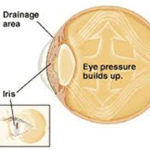
January is Glaucoma Awareness Month and in honor of it we want to talk about glaucoma in “regular people” terms. This way, patients and potential patients can truly understand glaucoma.
We’ve all heard the word but many of us, even those of us who have been diagnosed with it or who have a parent with it, do not know what it truly means.
Glaucoma is difficult to describe to a patient because there could be various conditions that cause it.
Most of the time glaucoma is caused by a high “IOP” or Intra Ocular Pressure. IOP is the pressure that comes from the fluid that circulates inside through the different structures in our eyes. This fluid is clear and is called aqueous humor.
Anything that slows or blocks the flow of this fluid out of the eye will cause pressure to build up in the eye. When the pressure goes up, it starts to affect and essentially eat away parts of our optic nerve. Our optic nerves are what connect our eyes to our brains. When your optic nerve starts to get affected, you lose parts of your vision that you cannot get back. Not even with treatment. The vision you lose due to glaucoma is permanent.
Glaucoma is considered a silent disease. Most of the time people aren’t aware there is a problem until they are seen by their eye doctor. In some cases, people don’t realize they have glaucoma for years.
This is one of the MANY reasons why it is so important to have your eyes checked even though you might think you have perfect vision. You always hear that you should see an eye doctor EVERY year which is so important. You also need to remember to let them dilate your pupils because the most important part of the screening process for glaucoma and most ocular diseases is the dilated portion of the exam. When the doctor puts dilating drops in your eyes, it makes your pupils larger and it gives the doctor much more room to examine through your pupil which allows for a much better analysis of your eyes to identify any conditions or diseases.
Yes, pupil dilation can be uncomfortable because you see blurry for a little while after, however, what is worse? Losing several minutes of your time where your vision is blurry or losing permanent areas of your vision?
When a doctor sees a patient who is complaining of vision loss that can’t be fixed with glasses or contacts, they do what is called a Visual Field test. This test will alert them to any areas of visual field loss. Glaucoma can be one of the culprits to cause this.
As far as treatments go, most patients that are diagnosed with glaucoma get put on eye drops. These drops will lower the pressure and therefore will reduce the damage to the optic nerve.
As a patient, your goal is to keep the pressure down by using your drops and following up with your doctors as needed in order to prevent any further loss of vision.
There are some other options that help glaucoma. There are now surgeries available where the surgeon can insert a microscopic instrument into your eye that will help drain the fluid and release the pressure. Also, it has been proven that when a patient who has glaucoma goes through cataract surgery, the removal of the cataract can sometimes cause the pressure to drop and again reduce the rate of the optic nerve head damage. Some patients who were on 2 different prescription glaucoma drops could cut back to one after cataract surgery. Please note: every person is different so this isn’t always the case.
Also, it is very important to note that glaucoma has a strong hereditary component which means if a family member has glaucoma, you should also be checked.
If you or a loved one has glaucoma, feel free to call us for an evaluation or for treatment options.
Please call us today at
to schedule an eye exam and have a Happy January!





